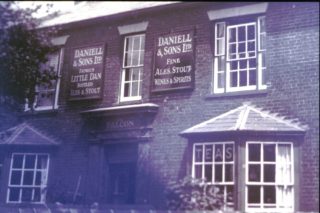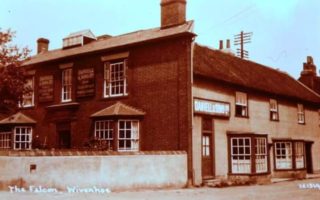Landlords of The Falcon
A long history of landlords from the 1500s until 1975
Terry Garland
This information was compiled while researching the history of The Falcon Inn
The Early Years – 1500s to 1800
Although the building dates from the 1400s there is little documentation of the early years during the ownership by the Martins. One can only surmise that there was a brewhouse on the premises to provide for the requirements of the Martins in their adjoining mansion. In Peter Kay’s book “Wivenhoe Pubs”, John Parker is listed as landlord of the Falcon in 1636 and there is a record in the Essex Assizes 1655 of John Parker, victualler of Wivenhoe, indicted for selling beer, presumably on a Sunday; the Assizes record though does not mention the name of a particular premises.
During the time of Samuel and Thomas Martin, Henry Everitt is listed at The Falcon in a 1741 ledger relating to contributions to the poor and in 1765 Thomas Corder [1733-1781] was recorded as the licensee of The Falcon. Three generations later, through marriages to the Goodwins, this family were landlords of The Grosvenor Hotel and The Black Buoy and had connections to other licensed premises in Wivenhoe.
Philip Lay [1739-1800] is recorded in Tax papers of 1798 as a tenant at The Falcon of John Adams of Alresford, the husband of Thomas Martin’s widow, and in 1801 the property was sold to his son, John Sarjant Lay [1779-1857] who became the first owner and licensee.
The Early 1800s
There is a gap in the records of licensees during the ownership of John Bawtree from 1805 to 1827. John Bawtree was described as an esquire of Colchester and would have been unlikely to have run the pub himself. There is one reference in the Conveyance of 1827 between John Sarjant Lay and Samuel Wade to the property being in the occupation of William Warner and he would seem to be the licensee for at least part of this gap.
Following the sale of The Falcon Inn to Thomas Turpin in 1827 we have two landlords; in 1828 Samuel Wade [1778-1852] and in 1832 Robert Pitt [1777-1849]. The Wades were an established Wivenhoe family and were connected by marriage to the Wheelers of the ‘Lay & Wheeler’ wine merchants; the Pitts were also an established family and, by the marriage of Robert’s son Benjamin to Sophia Corder, were to become closely linked to the licensed trade in Wivenhoe.
By 1839 Thomas Turpin [1797-1855] had taken over the licence for himself but as noted earlier he did not appear to be a good businessman and by 1842 was declared bankrupt. His daughter Jane had married James Gardner, landlord of The Greyhound and later The Rose and Crown where Thomas’s widow Jane died in 1896. Robert Turpin, whose relationship with Thomas is not clear, took over as licensee and owner until the sale in 1846 to John Gurdon Rebow.
During John Rebow’s ownership there are two landlords of whom little is known; in 1848 William Fisher and by 1851 John Fisher. By 1855 Abraham Ham had taken over as licensee. The Hams are again one of the families who appear regularly as licensees in Wivenhoe. Abraham was a mariner and sailed on one of the many yachts based in Wivenhoe in the 19th century. In 1852 Benjamin Pittock, Joseph Barr, Benjamin Blois, John Carter, Abraham Harvey and he had been summoned before the Mayor of Colchester and charged with smuggling tobacco and alcohol from Jersey on board the yacht Volante. As the quantities were small and no evidence was brought that showed they intended to sell the items only notional fines were imposed.
The Latter Part of the 1800s
In the 1861 census the younger brother of Abraham Ham, Nathaniel Rogers Ham [1828-1907], appears, with his wife and four children. Nathaniel is listed a seaman indicating that his wife Elizabeth was running the Inn while he was at sea. In 1871, 1881 and 1891 he is listed as a publican and mariner. Nathaniel was a licensed oyster dredger and member of the Colne Fishery Company and engaged his son as apprentice, although this was challenged in the High Court in 1899 following the refusal of the Colne Fishery Company to register his son as an oyster dredger.
Joseph Robinson was the licensee by 1894 but little is known of his background or time at the Inn. By 1899 Thomas William Younge [1833-1915] had taken over the licence and in 1908 Frederick M Knapp. Thomas Younge had moved from Fincham in Norfolk but apart from that these two are also not well documented.
The 1900s and better-known families of Wivenhoe
By 1910 and Benjamin Archer Barr [1857-1924] we are back to better known families of Wivenhoe. Benjamin’s grandfather had moved to Wivenhoe from Abberton around 1800 and by marriages to the Ham, Goodwin and Turner families they became involved with both the licensed victualler and maritime trades of the town. After Benjamin’s death in 1924 his widow Eliza Ann Barr [1858-1928] ran the pub for a further four years.
1929 saw Arthur William Southgate [1866-1929] take on the licence for the difficult times of the 1930s depression. He seems to have come and gone with no record of note, and appears unrelated to the other Southgates known in the town in the early 20th century.
In 1933 William Edward Elliott [1858-1934] moved to Wivenhoe after his marriage to his second wife Millicent Floyd in Romford. Inexplicably he left his estate on his death in 1934 to Frederick France Elliott a schoolmaster, although he left a widow, Millicent Alice Elliot [1887-1970] who became the licensee of The Falcon until 1940.
The Halliwells take over at the start of WWII
At the start of World War II, Henry Oswald Halliwell [1871-1945] moved from London to run The Falcon and the licence was transferred from Millicent Elliott on 11 Nov 1939. The Halliwells were a family of London licensed victuallers, his father Oswald having run The Oakley Arms in the City of London, The Star Tavern and The Phœnix in Belgravia and Henry himself running The Black Friar from 1911. He was no doubt relieved to move his family away from the dangers of the war living in the centre of the City of London.
The licence then passed to Henry’s son, Joseph John Halliwell [1917-1986], his father’s term as licensee mirroring the war from 1939-1945. Joseph was born at The Black Friar, a grade II listed pub near St Pauls in London which was built in about 1875 on the site of a former mediæval Dominican Friary and remodelled in 1905 as a magnificent example of the Arts and Crafts movement. During the 1950s one lodger at The Falcon was the captain of a ship from the Falkland Islands who stayed a number of years. The downstream shipyard of JW Cook was thriving at that time and Joseph provided lodgings for many of the Irish shipwrights employed there, all having to sleep in the snooker room above the bar. They owned a racing greyhound named “Sugar Plum” who was kennelled in the yard. Joseph was a generous soul, a non-smoker and teetotal, who would make cocoa for the customers at closing time. He was also very musical so many evenings were spent with either Rosie Marshall or Joseph on the old piano.
From 1956 until closure in 1975
Diana Louise Pilgrim is recorded in 1956 and Anthony Francis Pollendine in 1966 as the licensees. Despite their relatively recent occupations they do not appear in documents nor in the tales and rumours that circulate the town regarding the past landlords, although they were in occupancy during the memories of living residents of the town.
In 1968 the licence was taken over by Tadensz Stefan Motyka, born in Poland in 1919. He had been a member of the Polish Free Forces during the War and told improbable stories about his exploits in Italy. The Falcon was decorated with some of his war memorabilia. The building was by now in a run-down condition and he did little to improve its reputation. Wivenhoe Port was at this time importing timber from Gdansk in Poland and The Falcon, with a Polish speaking landlord, was the obvious watering hole for the ship crews. Stephan began a vodka smuggling business with the cases hidden in hollowed out parts of the timber stacks. With the Revenue men staked out on the church tower, he was caught red-handed, arrested and sent to prison.
Links to other pages on this website:
- The History of the The Falcon Inn by Terry Garland
- Memories of The Falcon by Helen Douzier daughter of Jo Halliwell
- Auctions at the Falcon in the 1800s
- Landlords and breweries of Wivenhoe Pubs
General Sources:
- Butler N, “The Story of Wivenhoe”, Quentin Press Wivenhoe, 1989.
- Barton D, “Wivenhoe: its attractions, pleasures and eccentric natives”, Dick Barton Enterprises 1975.
- Census Returns of England and Wales. Kew, Public Record Office, 1841-1901.
- Essex Church of England Parish Registers. Chelmsford, Essex Record Office.
- Kay P, “Wivenhoe Pubs”, published by Peter Kay 2003.
- National Probate Calendar (Index of Wills and Administrations) England & Wales, 1858-1966, 1973-1995.Kew, Public Record Office
- Trade Directories: UK, City and County Directories, 1766 – 1946.
- Trade Directories: London, General Post Office and Kelly’s Directories 1871 to 1906.
- The British Newspaper Archive. Dundee & London, Findmypast Newspaper Archive Limited & British Library, 2020
- Property deeds 1748-1887, held by Andrew Wheatley.









No Comments
Add a comment about this page